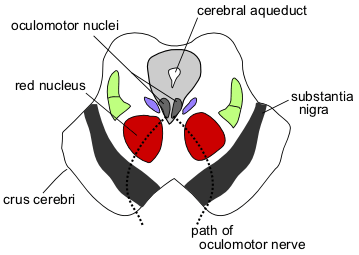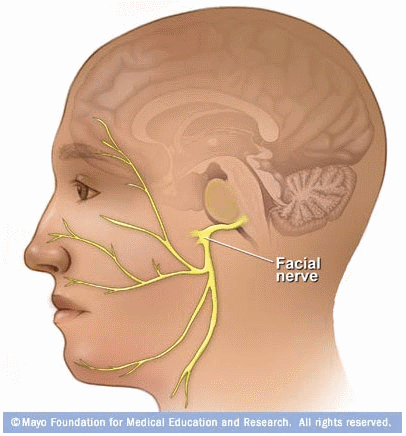Answer: The red nucleus is a midbrain structure that is involved in movement and motor control.
from https://en.wikipedia.org/wiki/Red_nucleus
The red nucleus functions as a motor control pathway, sending movement commands towards the body via axon projections. This bundle of axons together are called the rubrospinal tract. This tract largely terminates in the cervical region of the spinal cord. Therefore, outputs from the red nucleus are more important for mediating upper limb movements, but not for lower limb movement. This bundle of axons contains fewer projections than the corticospinal tract, indicating that the red nucleus plays a smaller role in directing motor output. Red nucleus outputs can mediate both large muscle movements as well as fine motor control, but generally not for innervation of the hands.
Anatomically, the red nucleus is located in the tegmentum of the midbrain. It is adjacent to the substantia nigra, a brain structure that is vitally important for motor control, as cells in this area are lost in patients presenting with Parkinson’s disease. The posterior end of the red nucleus is the decussation of the superior cerebellar peduncle. The anterior end goes to the fasciculus retroflexus.
The red nucleus also sends projections into the inferior olive in the medulla, then into the cerebellum.
This area is called the red nucleus because of its slightly pinkish appearance in the brain. The region is believed to be rich with iron in the form of hemoglobin and ferritin.
Function
It is believed that the red nucleus is an evolutionary remnant that developed before the corticospinal tract. In non-primate vertebrates, the red nucleus is the primary motor control pathway. In babies, they often rely on red nucleus for mediating crawling behaviors, but after the myelination of the corticospinal tract, they switch to using these axons for conveying the main motor outputs.
The red nucleus plays a role in the learned Pavlovian conditioned eye blink response. When the red nucleus is experimentally destroyed, the conditioned eye blink response is abolished. Inactivation of the red nucleus with a local injection of lidocaine results in altered blink behavior in rabbits (The temporary inactivation of the red nucleus affects performance of both conditioned and unconditioned nictitating membrane responses in the rabbit).



